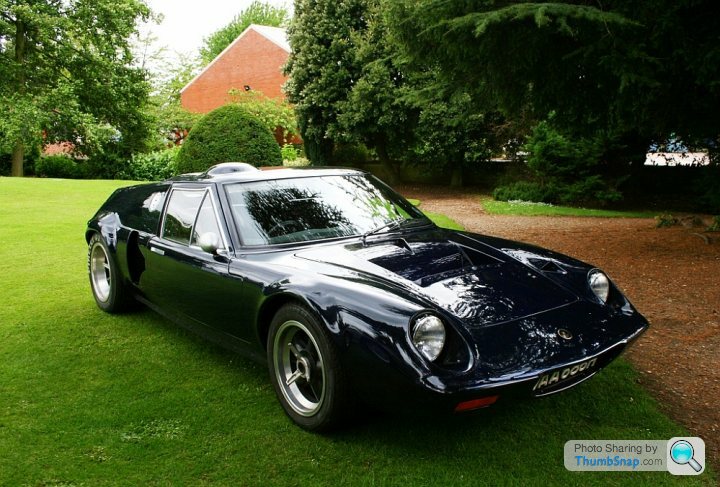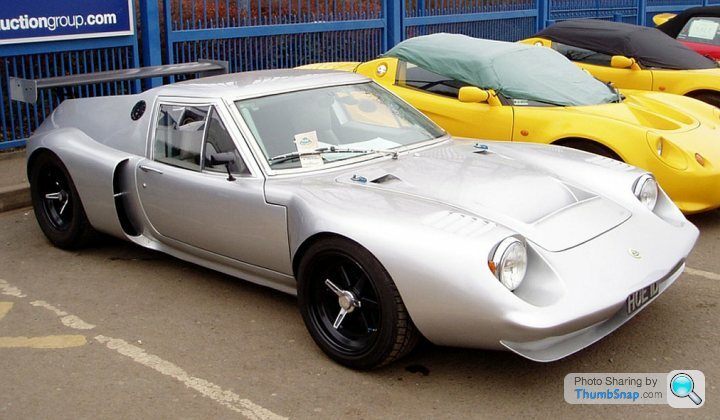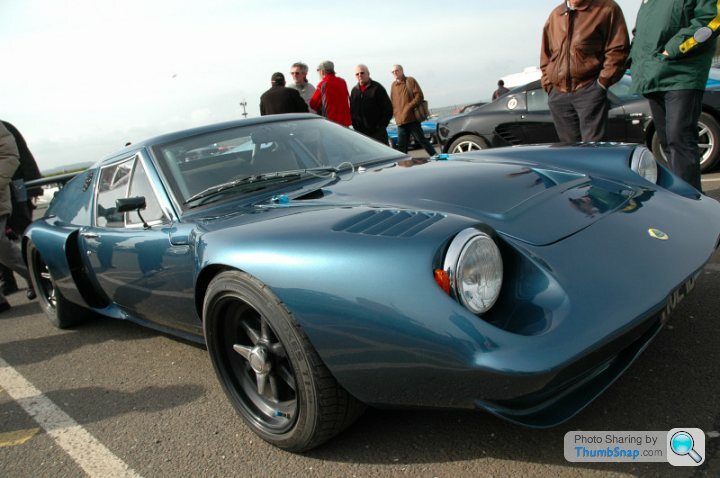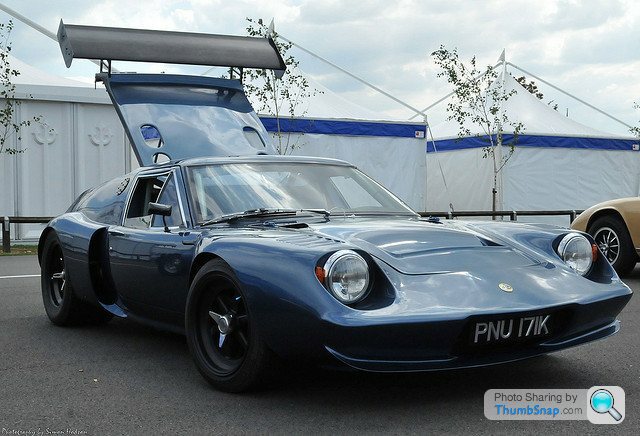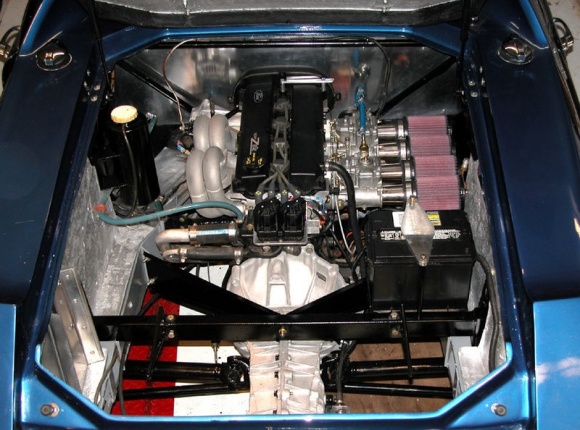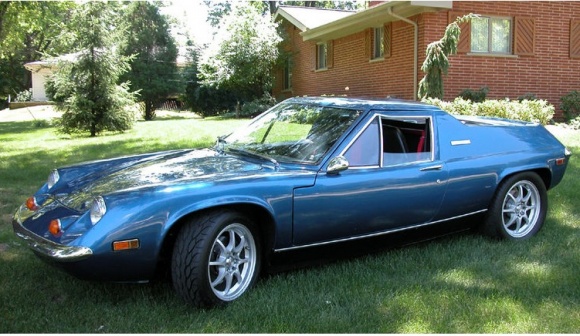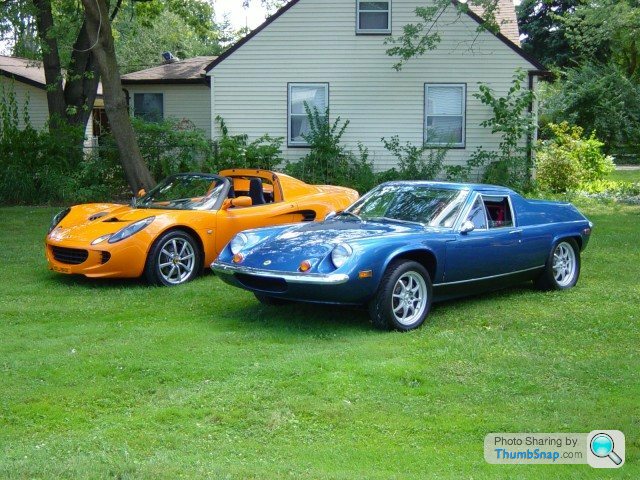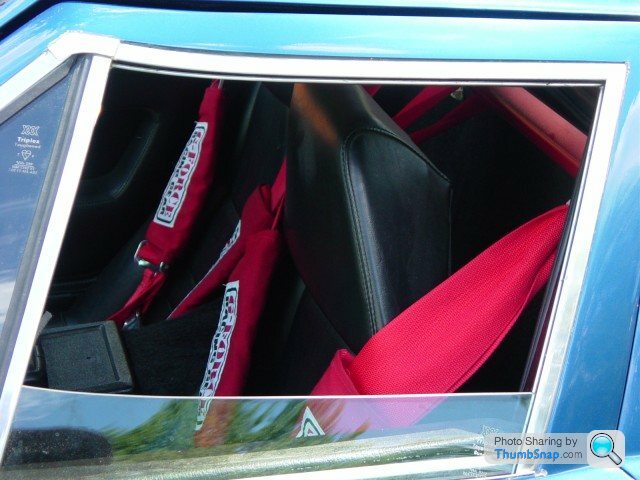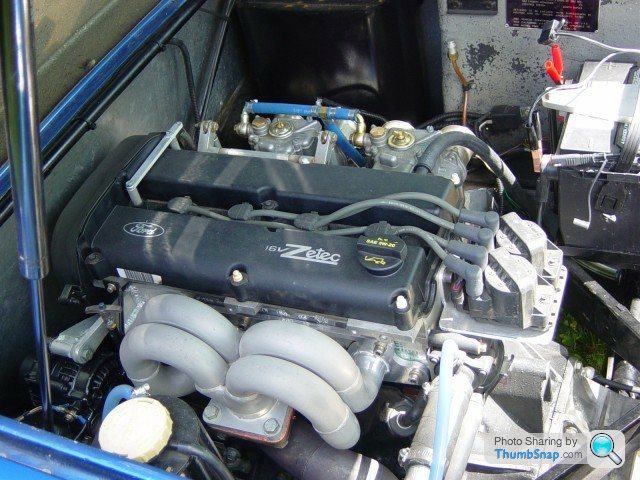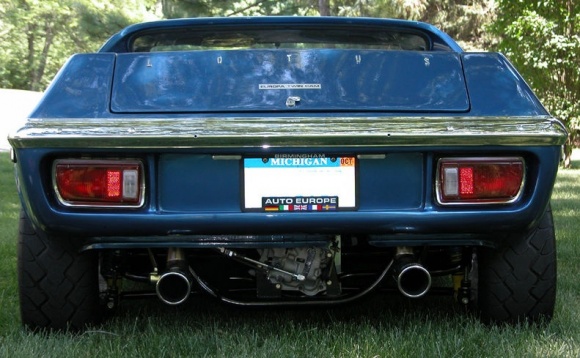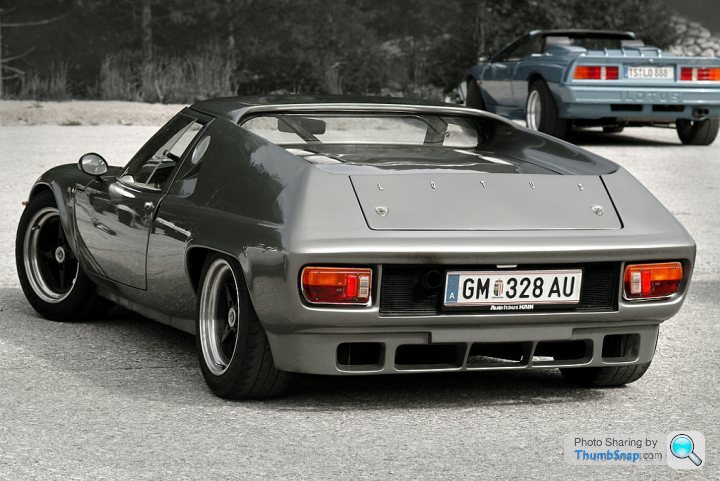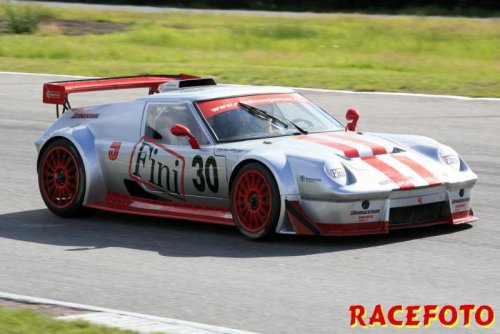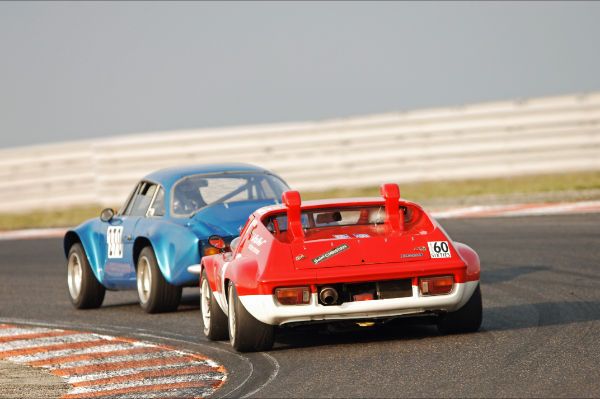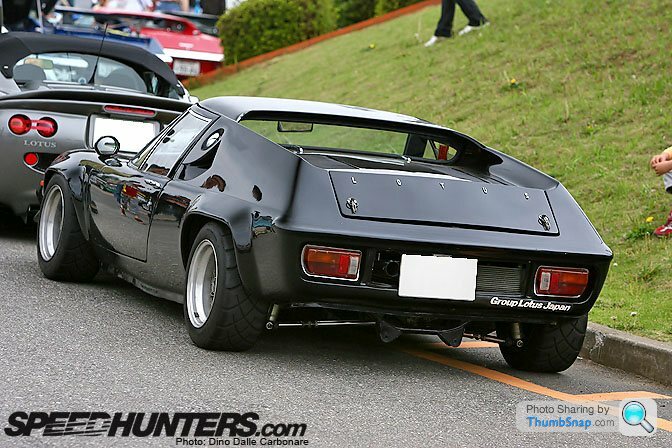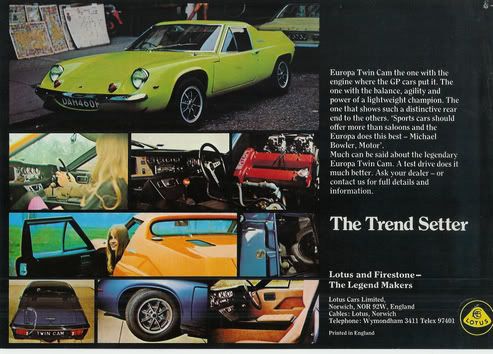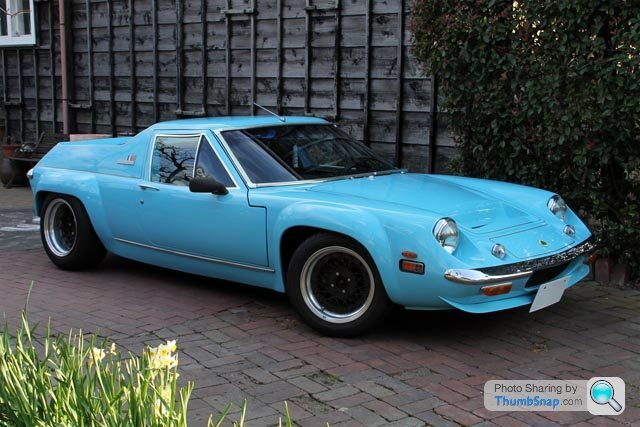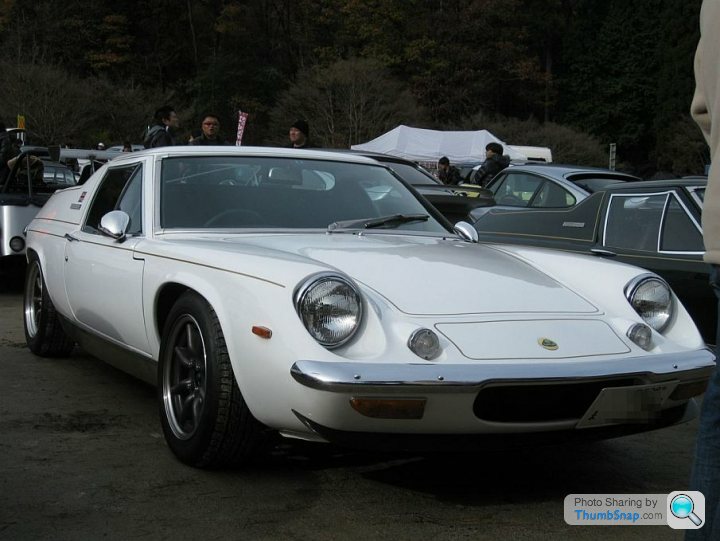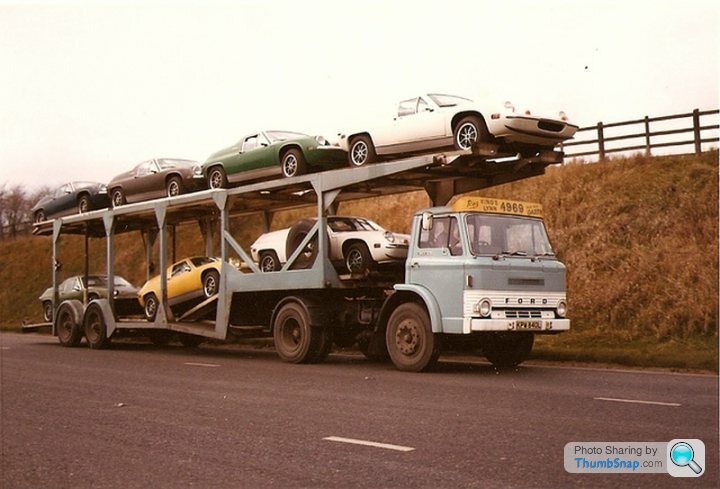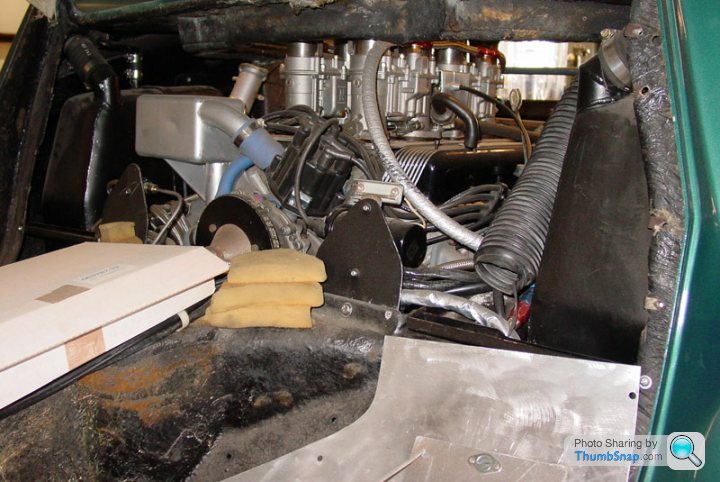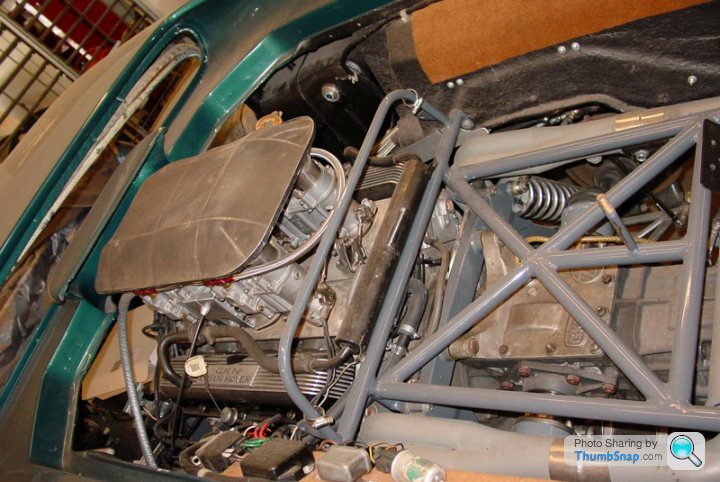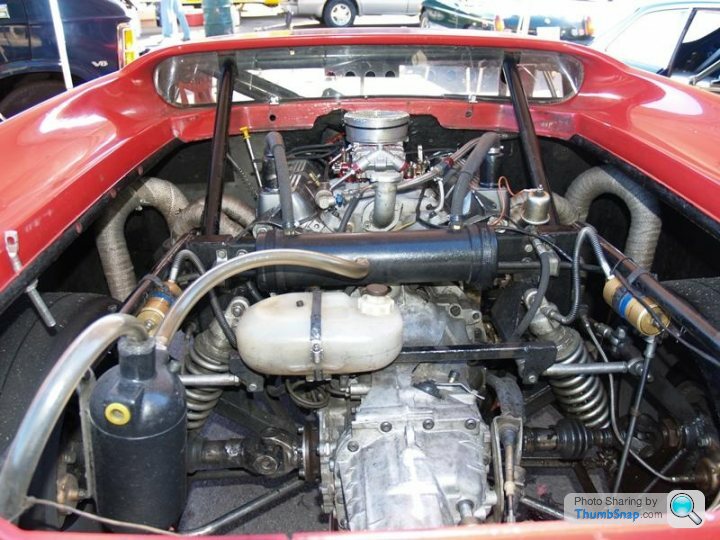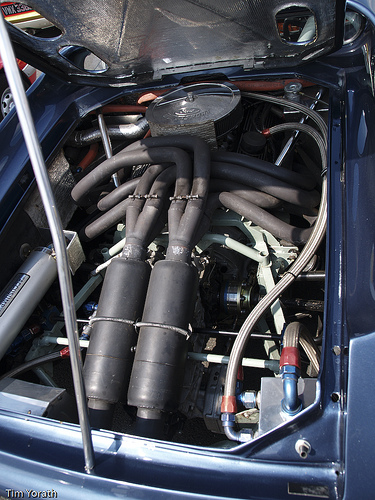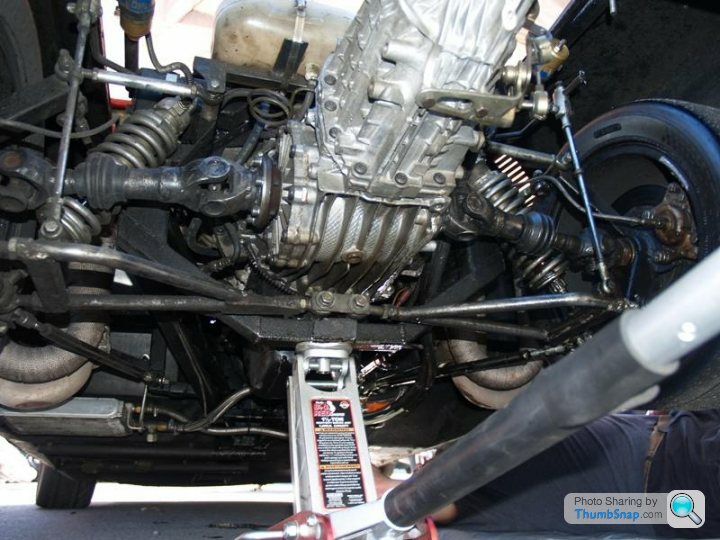Lotus Europa 1966-1975 & tuning & conversions etc
Discussion
Hi, sadly there is no sub category for the Lotus Classics which is a shame,
so I post it here to start a big thread with all about and around the
Lotus Europa from 1966-1975
and the "newer" build, old style Europa's like say Banks and or Spydercars and or specials.
street and or race and or rally you name it.
For info and talks and tuning and picture's and conversions etc, all around and about those cars.
Those cars were/are known of their lightweight and very fast on the track or b-roads.
I start with a few picture's to start with, and you readers can fill in a lot more over time, I think those cars deserve more attention.
this is more the S1 type and the S2 also looks like such with the high wings.
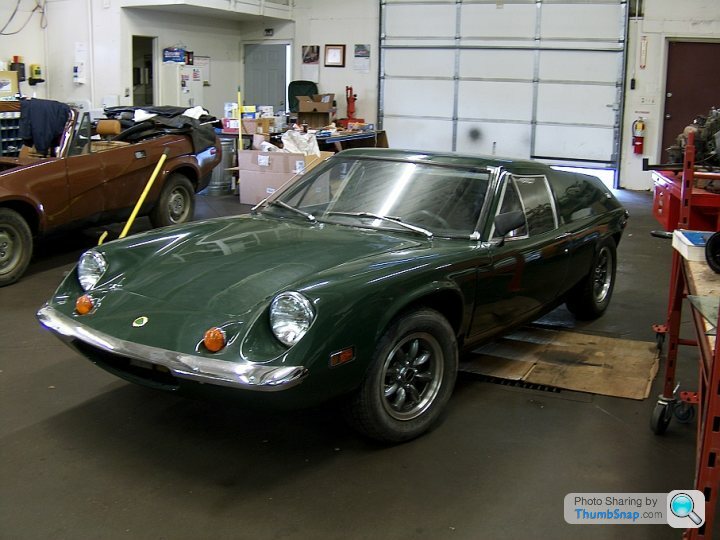
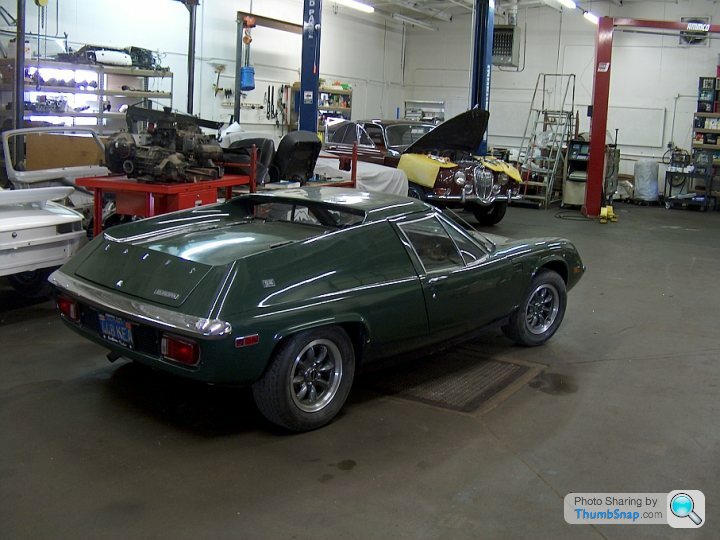
personally I'm more a fan of the later type 74 with the lower wings for a better view, a bit like those>
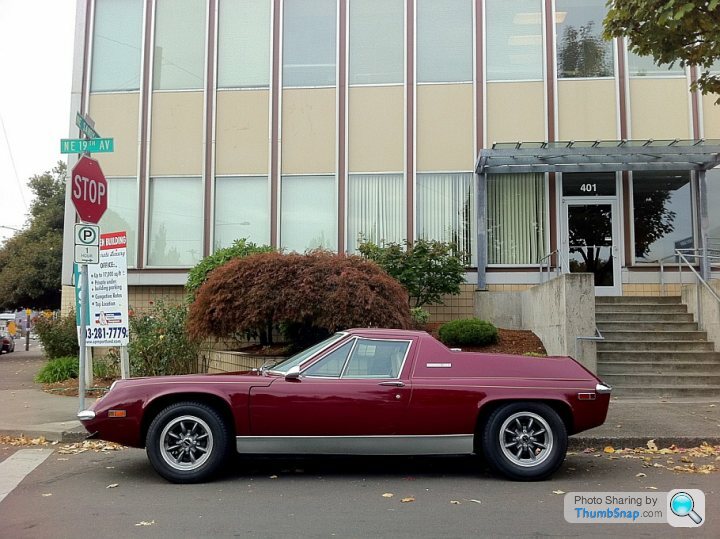
or in those JPS looks>
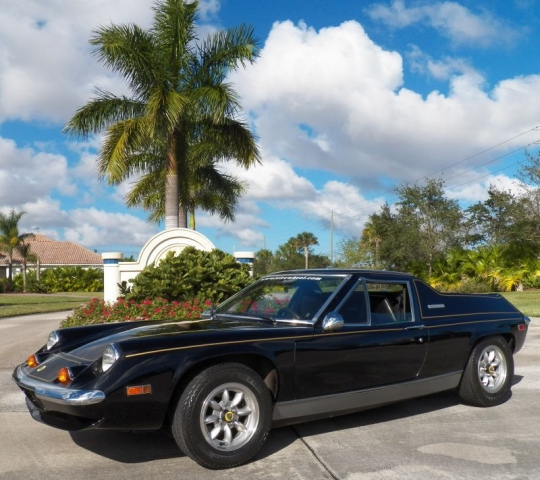
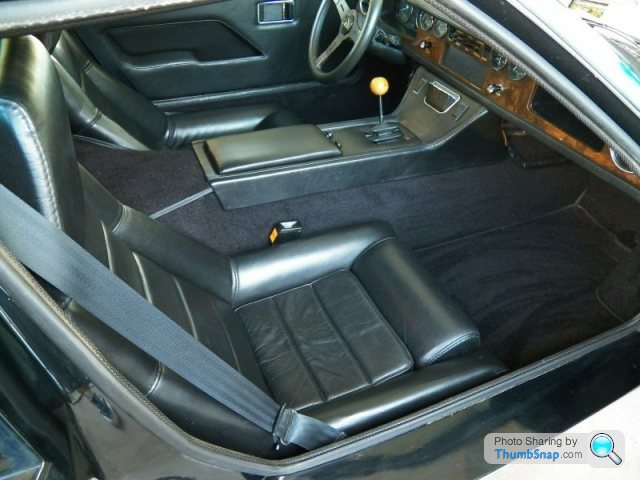
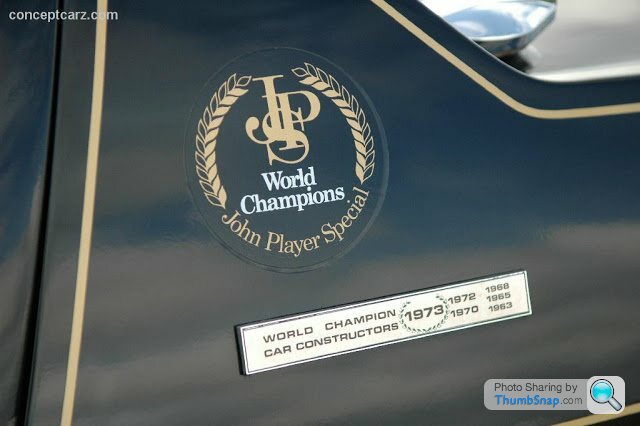
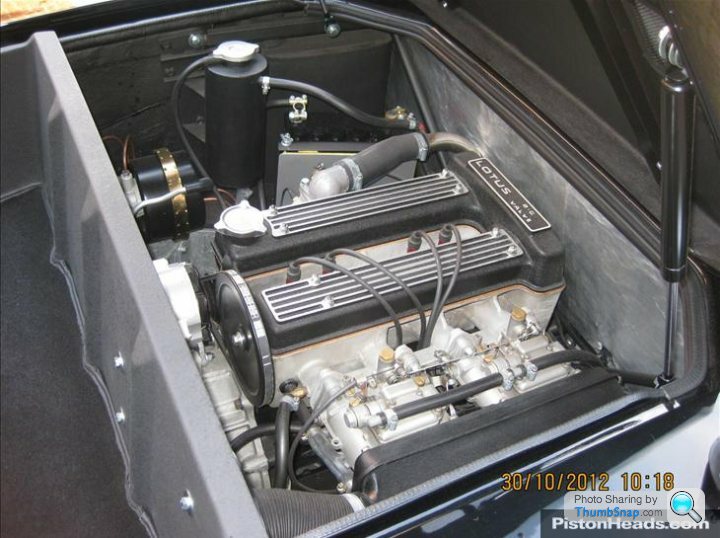
the cars came with a few different engine's over time, from alu Renault engine's to Ford TC Lotus engine's, at the time they had not many choices in gearbox so they limited the power is what I read.
Those days though you can get more type gearboxes which can handle more power :-) and good replacement engine's as well if you like.
I've seen V6 and V8 and rotary engine's and or Honda etc, but most common replacement is I guess the Zetec engine.
so I post it here to start a big thread with all about and around the
Lotus Europa from 1966-1975
and the "newer" build, old style Europa's like say Banks and or Spydercars and or specials.
street and or race and or rally you name it.
For info and talks and tuning and picture's and conversions etc, all around and about those cars.
Those cars were/are known of their lightweight and very fast on the track or b-roads.
I start with a few picture's to start with, and you readers can fill in a lot more over time, I think those cars deserve more attention.
this is more the S1 type and the S2 also looks like such with the high wings.


personally I'm more a fan of the later type 74 with the lower wings for a better view, a bit like those>

or in those JPS looks>




the cars came with a few different engine's over time, from alu Renault engine's to Ford TC Lotus engine's, at the time they had not many choices in gearbox so they limited the power is what I read.
Those days though you can get more type gearboxes which can handle more power :-) and good replacement engine's as well if you like.
I've seen V6 and V8 and rotary engine's and or Honda etc, but most common replacement is I guess the Zetec engine.
borrowed some info from wiki 
http://en.wikipedia.org/wiki/Lotus_Europa

said:
The Series 1 or S1 Europa (also known as Lotus Type 46)
was announced for sale to European markets on December 20, 1966. The first cars were delivered in France in February 1967. The S1 was fitted with a modified Renault 16 1470 cc inline-four engine and a 4-speed gearbox. The engine was a special 82 hp (61 kW) version (as opposed to the 52 hp (39 kW) generated in standard form). Lotus associated the affordable but lightweight Renault engine and gearbox to the revolutionary Europa longitudinal mid-engined layout, inverting the gearbox's crown wheel on its pinion gear to avoid having four reverse gears. The S1 weighed 610 kg (1512 lb), Autocar magazine achieved a top speed of 121 mph (195 km/h), and did 0–60 mph in 9.3 seconds. Of particular note, in excess of 0.9 g (8 m/s²) lateral acceleration was consistently achieved by Car magazine on road tires of that era.
Only 296 examples of the S1 were manufactured (chassis numbers from 460001 to 460296). These are the rarest on the market. These cars had extremely light and minimalist construction, with fixed side windows, fixed seats (adjustable pedals needing the use of tools), no door handles, no internal door covers, and an aluminum dashboard. The steel chassis central beam was sandwiched (incorporated) within the fibreglass bodywork, thus reinforcing stiffness, but making repair rather complicated.
Series 1A and B (around 350 built) had removable side windows, wooden dashboard, and internal door panel covers which could accommodate the windows once taken off. Series 1B had a redesigned rear panel, with new, rectangular light clusters.
Including the S1A and S1B (which incorporated some of the later S2 changes) variations, 644 Europa S1s were manufactured. From Series 2 (Chassis Number 0645 onwards), the glassfibre bodywork was not glued to the chassis any longer but bolted and therefore could be separated for repairs.
was announced for sale to European markets on December 20, 1966. The first cars were delivered in France in February 1967. The S1 was fitted with a modified Renault 16 1470 cc inline-four engine and a 4-speed gearbox. The engine was a special 82 hp (61 kW) version (as opposed to the 52 hp (39 kW) generated in standard form). Lotus associated the affordable but lightweight Renault engine and gearbox to the revolutionary Europa longitudinal mid-engined layout, inverting the gearbox's crown wheel on its pinion gear to avoid having four reverse gears. The S1 weighed 610 kg (1512 lb), Autocar magazine achieved a top speed of 121 mph (195 km/h), and did 0–60 mph in 9.3 seconds. Of particular note, in excess of 0.9 g (8 m/s²) lateral acceleration was consistently achieved by Car magazine on road tires of that era.
Only 296 examples of the S1 were manufactured (chassis numbers from 460001 to 460296). These are the rarest on the market. These cars had extremely light and minimalist construction, with fixed side windows, fixed seats (adjustable pedals needing the use of tools), no door handles, no internal door covers, and an aluminum dashboard. The steel chassis central beam was sandwiched (incorporated) within the fibreglass bodywork, thus reinforcing stiffness, but making repair rather complicated.
Series 1A and B (around 350 built) had removable side windows, wooden dashboard, and internal door panel covers which could accommodate the windows once taken off. Series 1B had a redesigned rear panel, with new, rectangular light clusters.
Including the S1A and S1B (which incorporated some of the later S2 changes) variations, 644 Europa S1s were manufactured. From Series 2 (Chassis Number 0645 onwards), the glassfibre bodywork was not glued to the chassis any longer but bolted and therefore could be separated for repairs.
said:
Type 47 and 62
Although the original Europa was intended as a clubmans sports racer to replace the Lotus 7, it was realised that the car would be uncompetitive with the Renault engines available. A decision was therefore made for Lotus Components to manufacture a specialist race car based on the Europa to be raced by Team Lotus and sold to private entrants. Although the very first Type 47 was based on a modified Europa, all subsequent cars were produced entirely by Lotus Components rather than the main factory. Launched at the same time as the S1 Europa, the body of the 47 was thinner than the standard Europa and with larger wheel arches. Side vents into the engine bay were added after the 1st few cars experiencing problems with engine bay temperature.
The Engine, Gearbox and rear suspension were completely different to the standard Europa and were taken in their entirety from the Lotus 23/Lotus 22 Formula Junior with a Lotus-Ford Twin Cam based 165 hp (123 kW) 1,594 cc Cosworth Mk.XIII dry sump engine, and a Hewland FT 200 5-speed gearbox and suspension with reversed bottom wishbone, top link and dual radius arms. The front upright was specially cast in common with the F2 version of Lotus 41X to accommodate a larger Girling brake for the later 47A model (which had the Alfa Romeo tail lamp shared with the Europa S2) with reinforced front frame.
The Type 47 is fondly remembered for taking both first and second places (driven by John Miles and Jackie Oliver, respectively) in its very first race held at the storied Brands Hatch race course on Boxing Day. Exact production numbers are unknown, the last car was 47GT-85 but it is unlikely 85 47GT's were produced, estimates vary from 55 to 68 during the years 1966-70. Although the 47GT is the best known, a few 47F's were produced, these had the detachable body similar to the S2 Europa, but retaining the large wheel arches and side vents of the 47GT. Fitted with a tuned Ford cross flow engine but with the Renault gearbox and rear suspension of the Europa. The number produced is unknown but probably no more than 6.
As a mobile test bed for the new 2 litre Lotus 907 engine being developed for the forthcoming Elite and Eclat, the Type 62 was produced. Only two such cars were ever made. These were space frame cars with F1 suspension to handle the 240 hp from the engine. Although deliberately made to resemble the Europa in practice the only connection to the Europa was a few of the Europa's body panels. It did win its first event the 1969 BOAC 500 at Brands Hatch with John Miles and Brian Muir at the wheel. Replica 47's and 62's are bespoke-manufactured by Banks Europa Engineering, in several variations. A one-off 47, fitted with a Rover V8 engine (3.5 litre bored out to 4.4 litre), was built for GKN in 1968 and registered, GKN 47 D, with 300 hp it was capable of 180 mph (290 km/h).
Although the original Europa was intended as a clubmans sports racer to replace the Lotus 7, it was realised that the car would be uncompetitive with the Renault engines available. A decision was therefore made for Lotus Components to manufacture a specialist race car based on the Europa to be raced by Team Lotus and sold to private entrants. Although the very first Type 47 was based on a modified Europa, all subsequent cars were produced entirely by Lotus Components rather than the main factory. Launched at the same time as the S1 Europa, the body of the 47 was thinner than the standard Europa and with larger wheel arches. Side vents into the engine bay were added after the 1st few cars experiencing problems with engine bay temperature.
The Engine, Gearbox and rear suspension were completely different to the standard Europa and were taken in their entirety from the Lotus 23/Lotus 22 Formula Junior with a Lotus-Ford Twin Cam based 165 hp (123 kW) 1,594 cc Cosworth Mk.XIII dry sump engine, and a Hewland FT 200 5-speed gearbox and suspension with reversed bottom wishbone, top link and dual radius arms. The front upright was specially cast in common with the F2 version of Lotus 41X to accommodate a larger Girling brake for the later 47A model (which had the Alfa Romeo tail lamp shared with the Europa S2) with reinforced front frame.
The Type 47 is fondly remembered for taking both first and second places (driven by John Miles and Jackie Oliver, respectively) in its very first race held at the storied Brands Hatch race course on Boxing Day. Exact production numbers are unknown, the last car was 47GT-85 but it is unlikely 85 47GT's were produced, estimates vary from 55 to 68 during the years 1966-70. Although the 47GT is the best known, a few 47F's were produced, these had the detachable body similar to the S2 Europa, but retaining the large wheel arches and side vents of the 47GT. Fitted with a tuned Ford cross flow engine but with the Renault gearbox and rear suspension of the Europa. The number produced is unknown but probably no more than 6.
As a mobile test bed for the new 2 litre Lotus 907 engine being developed for the forthcoming Elite and Eclat, the Type 62 was produced. Only two such cars were ever made. These were space frame cars with F1 suspension to handle the 240 hp from the engine. Although deliberately made to resemble the Europa in practice the only connection to the Europa was a few of the Europa's body panels. It did win its first event the 1969 BOAC 500 at Brands Hatch with John Miles and Brian Muir at the wheel. Replica 47's and 62's are bespoke-manufactured by Banks Europa Engineering, in several variations. A one-off 47, fitted with a Rover V8 engine (3.5 litre bored out to 4.4 litre), was built for GKN in 1968 and registered, GKN 47 D, with 300 hp it was capable of 180 mph (290 km/h).
said:
The Europa S2, or Type 54,
was introduced in April 1968. It used the same Renault engine as the Type 46, but offered a number of refinements, including electric windows, fully adjustable seats, a new interior, and a polished wooden fascia for the dashboard. Per request of the automotive insurance industry, Lotus switched to bolt fasteners (instead of resin bonding) to attach body to frame. A small number of Type 54s were modified to be "federalized", that is, made suitable for export to the United States. The Federal Type 54 was slightly modified. They were actually recalled because of the headlamps being too low (a "bug eye" headlamp raiser was to be installed). The Federal 54 had the low fenders of the European 54, but larger engine of the type 65. Perhaps 200 of these were made[citation needed].
In 1969-70, the Type 65 (also known as S2 Federal) was born specifically for export to the US, with additional changes to the body, chassis, suspension and the powerplant to better comply with U.S. D.O.T. standards. Production of the 54 continued for cars supplied to the rest of the world. Among the changes, the engine was a slightly modified emission controlled Renault 16TL 1565 cc engine producing 80 hp rather than the 1470 cc engine of the Type 54. The front suspension was changed to make the front end of the car taller along with taller front fenders to raise the headlamps. Road&Track Magazine tested the Federal S2 and recorded 0-60 mph in 9.6 seconds with a top speed of 116 mph (187 km/h). 3,615 S2s were produced.
The Swiss Lotus importer also made two special versions fitted with the Renault 16 TS type 807 engine, the "Europa Hemi 807" and the fuel injected "Europa Black Shadow 807". The Hemi 807 had 105 PS (77 kW) SAE and could reach 200 km/h (124 mph), while the Black Shadow had 137 PS (101 kW) on tap. The Black Shadow also received a five-speed gearbox.[4] These cars had a wider track, special wheels and stickers, white indicator lights up front, and featured extractor vents high on the side panel behind the rear door. The fuel injection system was from Kugelfischer.
was introduced in April 1968. It used the same Renault engine as the Type 46, but offered a number of refinements, including electric windows, fully adjustable seats, a new interior, and a polished wooden fascia for the dashboard. Per request of the automotive insurance industry, Lotus switched to bolt fasteners (instead of resin bonding) to attach body to frame. A small number of Type 54s were modified to be "federalized", that is, made suitable for export to the United States. The Federal Type 54 was slightly modified. They were actually recalled because of the headlamps being too low (a "bug eye" headlamp raiser was to be installed). The Federal 54 had the low fenders of the European 54, but larger engine of the type 65. Perhaps 200 of these were made[citation needed].
In 1969-70, the Type 65 (also known as S2 Federal) was born specifically for export to the US, with additional changes to the body, chassis, suspension and the powerplant to better comply with U.S. D.O.T. standards. Production of the 54 continued for cars supplied to the rest of the world. Among the changes, the engine was a slightly modified emission controlled Renault 16TL 1565 cc engine producing 80 hp rather than the 1470 cc engine of the Type 54. The front suspension was changed to make the front end of the car taller along with taller front fenders to raise the headlamps. Road&Track Magazine tested the Federal S2 and recorded 0-60 mph in 9.6 seconds with a top speed of 116 mph (187 km/h). 3,615 S2s were produced.
The Swiss Lotus importer also made two special versions fitted with the Renault 16 TS type 807 engine, the "Europa Hemi 807" and the fuel injected "Europa Black Shadow 807". The Hemi 807 had 105 PS (77 kW) SAE and could reach 200 km/h (124 mph), while the Black Shadow had 137 PS (101 kW) on tap. The Black Shadow also received a five-speed gearbox.[4] These cars had a wider track, special wheels and stickers, white indicator lights up front, and featured extractor vents high on the side panel behind the rear door. The fuel injection system was from Kugelfischer.
said:
In 1971, the Type 74 Europa Twin Cam
was made available to the public, with a 105 bhp 1557cc Lotus-Ford Twin Cam engine (105 bhp US "Federal" emission standard emissions control version with Stromberg carbs, until the end of production) and a re-designed bodyshell to improve rearward visibility. Initially with the same gearbox as the earlier cars, once the supply had been exhausted in 1972 a new stronger Renault 4-speed gearbox (Type 352) was introduced. Mike Kimberley, who rose to become chief executive of Group Lotus, then a new engineer at Lotus, was appointed Chief Engineer of the Europa TC project. 1,580 cars were shipped as Europa "Twin Cam" before Lotus switched to a 126 bhp "Big Valve" version of the engine The "Europa Special" version aspirated by Dell'Orto carburettors version of the same engine; in addition to offering a new Renault 5-speed (Type 365) gearbox option. It weighed 740 kg (1631 lb), Motor magaxine famously tested a UK Special to a top speed of 123 mph (198 km/h), did 0–60 mph in 6.6 seconds, and ran the 1/4 mile in 14.9 sec. This at a time when all road tests were carried out with both a driver and passenger, with only the driver on board the 0–60 mph time would have been well under 6 seconds, a phenomenal performance for the period. Introduced in September 1972 the first 100 big valve cars were badged and painted to honour the just won Team Lotus's 1972F1 World Championship title with John Player Special as sponsors, all with 5 speed gearbox, these were all black with gold pin stripe matching the livery of the GP cars – plus a numbered JPS dash board badge, becoming the first ever John Player Special commemorative motor vehicles. The "Special" name and colour scheme was planned to be dropped after the first 200 cars, reverting to the Twin Cam name, but such was the reaction to the new car that the name and pin stripe scheme remained until the end of Europa Production although colours other than black were made available. In the end only the numbered plaque distinguishing the first 100 JPS cars from other black Europa Specials. In total 4710 Type 74's were produced of which 3130 were "Specials".
(According to Lotus sources, no Special left the factory with "numbered JPS badges" or "JPS stickers" - these were added by the American importer & weren't official done by Lotus. There were no "badged" cars sold in the UK, Australia, etc. just the USA).
source about the Lotus Europa and more info, also about a little GT40 connection (sort of) was made available to the public, with a 105 bhp 1557cc Lotus-Ford Twin Cam engine (105 bhp US "Federal" emission standard emissions control version with Stromberg carbs, until the end of production) and a re-designed bodyshell to improve rearward visibility. Initially with the same gearbox as the earlier cars, once the supply had been exhausted in 1972 a new stronger Renault 4-speed gearbox (Type 352) was introduced. Mike Kimberley, who rose to become chief executive of Group Lotus, then a new engineer at Lotus, was appointed Chief Engineer of the Europa TC project. 1,580 cars were shipped as Europa "Twin Cam" before Lotus switched to a 126 bhp "Big Valve" version of the engine The "Europa Special" version aspirated by Dell'Orto carburettors version of the same engine; in addition to offering a new Renault 5-speed (Type 365) gearbox option. It weighed 740 kg (1631 lb), Motor magaxine famously tested a UK Special to a top speed of 123 mph (198 km/h), did 0–60 mph in 6.6 seconds, and ran the 1/4 mile in 14.9 sec. This at a time when all road tests were carried out with both a driver and passenger, with only the driver on board the 0–60 mph time would have been well under 6 seconds, a phenomenal performance for the period. Introduced in September 1972 the first 100 big valve cars were badged and painted to honour the just won Team Lotus's 1972F1 World Championship title with John Player Special as sponsors, all with 5 speed gearbox, these were all black with gold pin stripe matching the livery of the GP cars – plus a numbered JPS dash board badge, becoming the first ever John Player Special commemorative motor vehicles. The "Special" name and colour scheme was planned to be dropped after the first 200 cars, reverting to the Twin Cam name, but such was the reaction to the new car that the name and pin stripe scheme remained until the end of Europa Production although colours other than black were made available. In the end only the numbered plaque distinguishing the first 100 JPS cars from other black Europa Specials. In total 4710 Type 74's were produced of which 3130 were "Specials".
(According to Lotus sources, no Special left the factory with "numbered JPS badges" or "JPS stickers" - these were added by the American importer & weren't official done by Lotus. There were no "badged" cars sold in the UK, Australia, etc. just the USA).
http://en.wikipedia.org/wiki/Lotus_Europa
Some good pics there, I do like the conversion on the S2 to 62 style, it looks very high quality work.
If you're looking for other owners there is a regular Yahoo group which has been around for years and a newer, modern style forum at;
http://www.lotuseuropa.org/LotusForum/index.php
Brian
If you're looking for other owners there is a regular Yahoo group which has been around for years and a newer, modern style forum at;
http://www.lotuseuropa.org/LotusForum/index.php
Brian
Allandwf said:
I'm looking for TTC 556H, 1969 S2 I used to own, originaly yellow, last seen painted black with gold pinstripes as JPS. with gold wolfrace alloys. Would love to know where it is.
maybe its moved to Germany...I have a few pictures of such sort europa as you describe...maybe they did also a from RHD to LHD conversion?
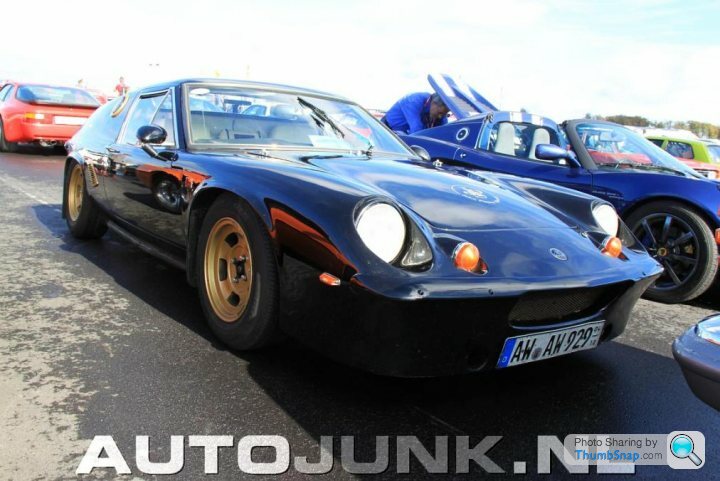
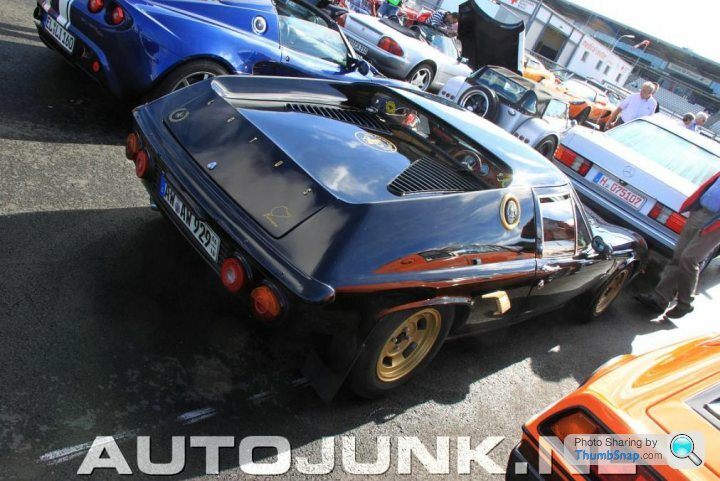
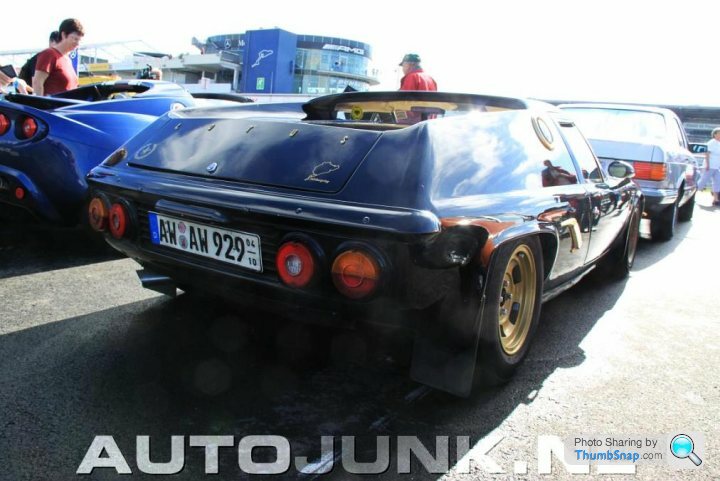
Those are some really impressively finished Europa's, I wish that mine was anywhere nearly as immaculate as them.
My Europa is very much modified on the outside but is very basic as far as the driveline is concerned (although it was possibly the first Fuego conversion done).
Link to images on the Europa pages here:
http://www.lotuseuropa.org/gallery/DinoEuropa
and a taster here:
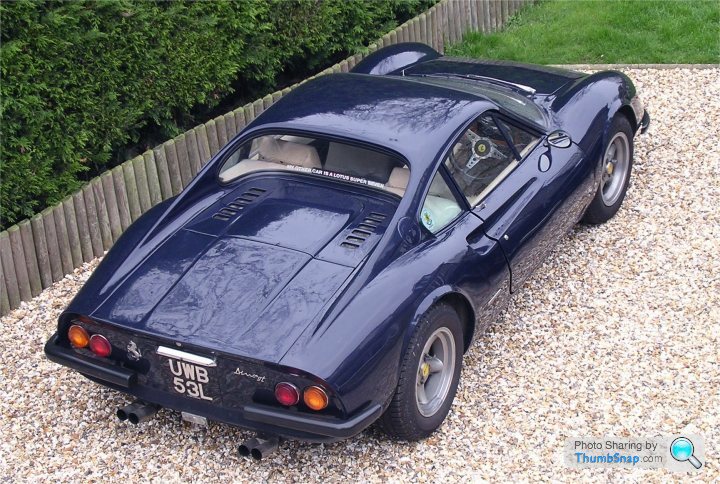
My Europa is very much modified on the outside but is very basic as far as the driveline is concerned (although it was possibly the first Fuego conversion done).
Link to images on the Europa pages here:
http://www.lotuseuropa.org/gallery/DinoEuropa
and a taster here:

Dorchester said:
Those are some really impressively finished Europa's, I wish that mine was anywhere nearly as immaculate as them.
My Europa is very much modified on the outside but is very basic as far as the driveline is concerned (although it was possibly the first Fuego conversion done).
Link to images on the Europa pages here:
http://www.lotuseuropa.org/gallery/DinoEuropa
and a taster here:

that looks really good, you could also fit a V6 My Europa is very much modified on the outside but is very basic as far as the driveline is concerned (although it was possibly the first Fuego conversion done).
Link to images on the Europa pages here:
http://www.lotuseuropa.org/gallery/DinoEuropa
and a taster here:


this one has a alfa v6
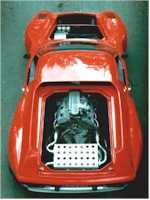
and I believe this engine also went into a Europa
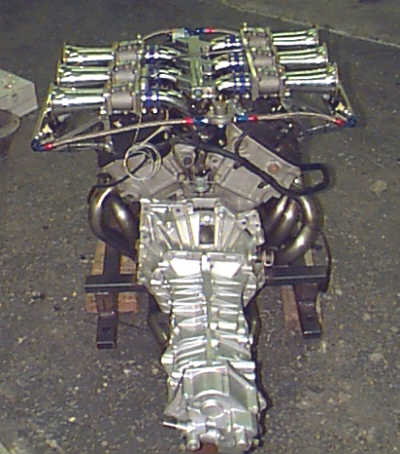
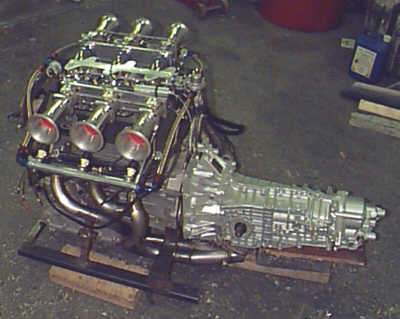
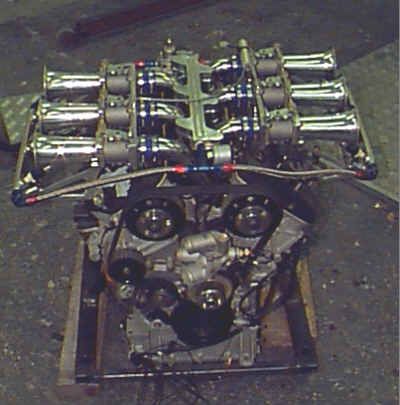
I have a '72 Europa TC. The engine went bang some years ago, so I have a Zetec 2.0 I am building for it. It already has Spyder chassis and rear suspension, rear discs etc. Fuego 5 speed gearbox. In gold Leaf colours too. Must find a pic somewhere.
Trouble is it has been pushed to the back of the queue for completing so many times. Ought to drag it out as soon as the Kougar is done - unless someone wants to buy it!!
Trouble is it has been pushed to the back of the queue for completing so many times. Ought to drag it out as soon as the Kougar is done - unless someone wants to buy it!!
I had a lovely 1972/73 Europa Special, in JPS livery, and a 1971/2 Europa Twin Cam in yellow. They were both very original cars, and I adored them. The Special is now in Hong Kong, and the Twin Cam in Australia. I have a Europa shaped hole in my life that I hope to fill one day.
The cars are pictured below.
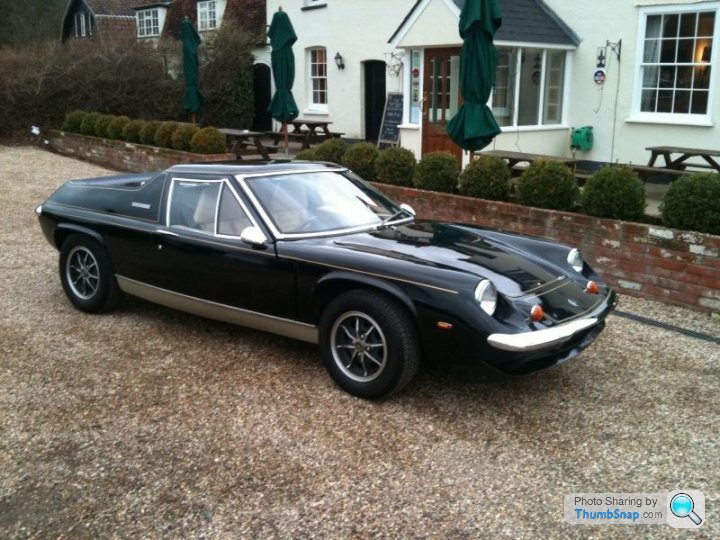
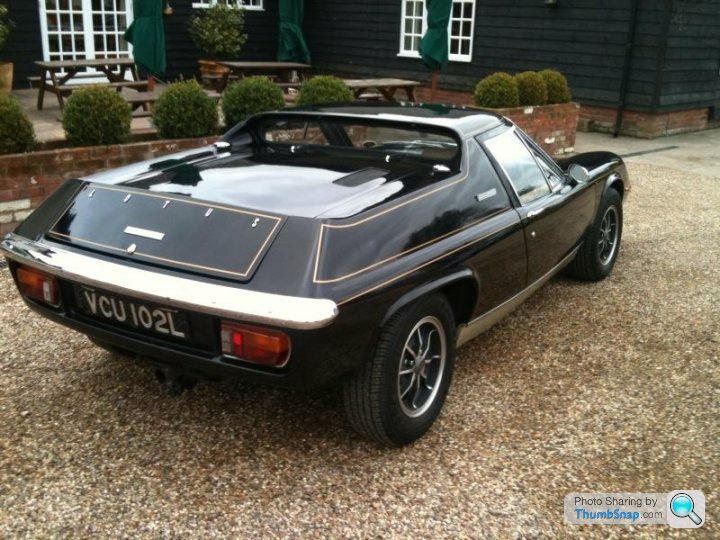
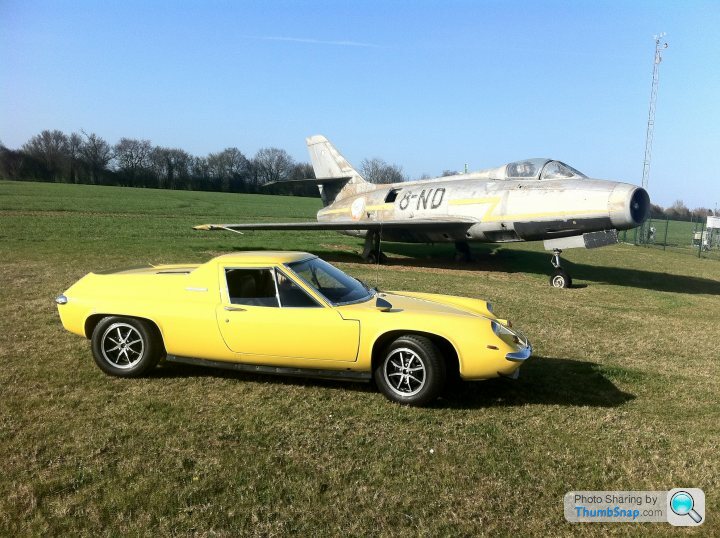
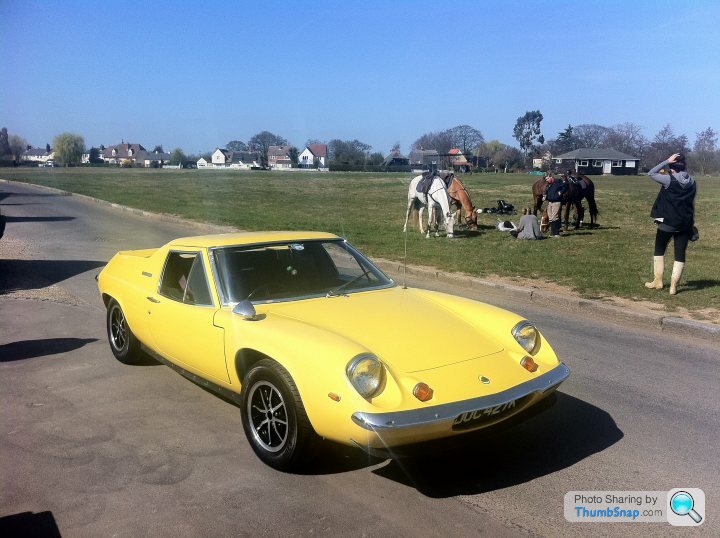
The cars are pictured below.




They should have made the fastest one.............. 
http://47d.org/47d/index.html
http://www.lotusespritturbo.com/Lotus_Europa_GKN_4...

http://47d.org/47d/index.html
http://www.lotusespritturbo.com/Lotus_Europa_GKN_4...
I am not a die hard purist, but I question those who think that they know better than Chapman's team of designers and engineers. The essence of a traditional Lotus is lightness and an engine that has punch, but power to weight ratio is the thing, not raw power. I am not persuaded by all these mods. Still, each to his own.
Gassing Station | General Lotus Stuff | Top of Page | What's New | My Stuff




